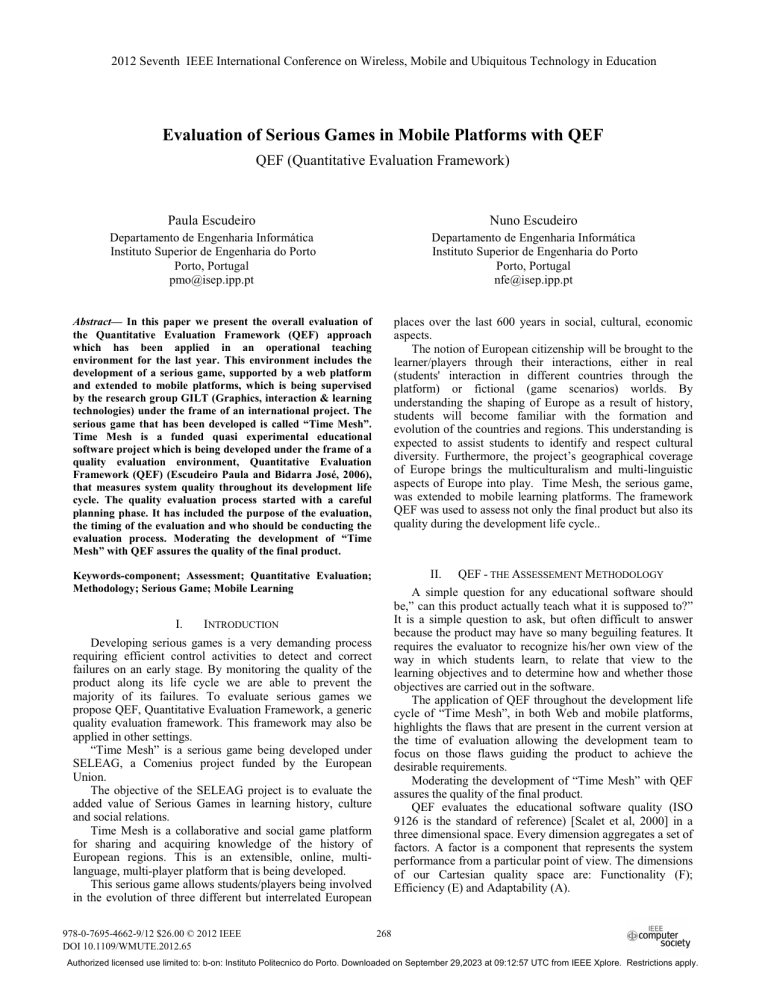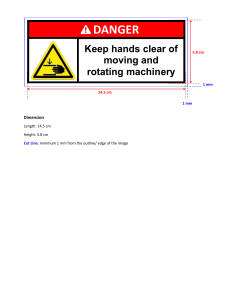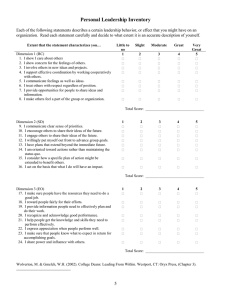Evaluation of Serious Games in Mobile Platforms with QEF QEF Quantitative Evaluation Framework
advertisement

2012 Seventh IEEE International Conference on Wireless, Mobile and Ubiquitous Technology in Education Evaluation of Serious Games in Mobile Platforms with QEF QEF (Quantitative Evaluation Framework) Paula Escudeiro Nuno Escudeiro Departamento de Engenharia Informática Instituto Superior de Engenharia do Porto Porto, Portugal pmo@isep.ipp.pt Departamento de Engenharia Informática Instituto Superior de Engenharia do Porto Porto, Portugal nfe@isep.ipp.pt Abstract— In this paper we present the overall evaluation of the Quantitative Evaluation Framework (QEF) approach which has been applied in an operational teaching environment for the last year. This environment includes the development of a serious game, supported by a web platform and extended to mobile platforms, which is being supervised by the research group GILT (Graphics, interaction & learning technologies) under the frame of an international project. The serious game that has been developed is called “Time Mesh”. Time Mesh is a funded quasi experimental educational software project which is being developed under the frame of a quality evaluation environment, Quantitative Evaluation Framework (QEF) (Escudeiro Paula and Bidarra José, 2006), that measures system quality throughout its development life cycle. The quality evaluation process started with a careful planning phase. It has included the purpose of the evaluation, the timing of the evaluation and who should be conducting the evaluation process. Moderating the development of “Time Mesh” with QEF assures the quality of the final product. places over the last 600 years in social, cultural, economic aspects. The notion of European citizenship will be brought to the learner/players through their interactions, either in real (students' interaction in different countries through the platform) or fictional (game scenarios) worlds. By understanding the shaping of Europe as a result of history, students will become familiar with the formation and evolution of the countries and regions. This understanding is expected to assist students to identify and respect cultural diversity. Furthermore, the project’s geographical coverage of Europe brings the multiculturalism and multi-linguistic aspects of Europe into play. Time Mesh, the serious game, was extended to mobile learning platforms. The framework QEF was used to assess not only the final product but also its quality during the development life cycle.. II. Keywords-component; Assessment; Quantitative Evaluation; Methodology; Serious Game; Mobile Learning I. INTRODUCTION Developing serious games is a very demanding process requiring efficient control activities to detect and correct failures on an early stage. By monitoring the quality of the product along its life cycle we are able to prevent the majority of its failures. To evaluate serious games we propose QEF, Quantitative Evaluation Framework, a generic quality evaluation framework. This framework may also be applied in other settings. “Time Mesh” is a serious game being developed under SELEAG, a Comenius project funded by the European Union. The objective of the SELEAG project is to evaluate the added value of Serious Games in learning history, culture and social relations. Time Mesh is a collaborative and social game platform for sharing and acquiring knowledge of the history of European regions. This is an extensible, online, multilanguage, multi-player platform that is being developed. This serious game allows students/players being involved in the evolution of three different but interrelated European 978-0-7695-4662-9/12 $26.00 © 2012 IEEE DOI 10.1109/WMUTE.2012.65 QEF - THE ASSESSEMENT METHODOLOGY A simple question for any educational software should be,” can this product actually teach what it is supposed to?” It is a simple question to ask, but often difficult to answer because the product may have so many beguiling features. It requires the evaluator to recognize his/her own view of the way in which students learn, to relate that view to the learning objectives and to determine how and whether those objectives are carried out in the software. The application of QEF throughout the development life cycle of “Time Mesh”, in both Web and mobile platforms, highlights the flaws that are present in the current version at the time of evaluation allowing the development team to focus on those flaws guiding the product to achieve the desirable requirements. Moderating the development of “Time Mesh” with QEF assures the quality of the final product. QEF evaluates the educational software quality (ISO 9126 is the standard of reference) [Scalet et al, 2000] in a three dimensional space. Every dimension aggregates a set of factors. A factor is a component that represents the system performance from a particular point of view. The dimensions of our Cartesian quality space are: Functionality (F); Efficiency (E) and Adaptability (A). 268 Authorized licensed use limited to: b-on: Instituto Politecnico do Porto. Downloaded on September 29,2023 at 09:12:57 UTC from IEEE Xplore. Restrictions apply. validated? Has it no orthographic errors? R10: Has the alert message been checked? Are there no pervasive or negative messages and no racial or religion discrimination? R11: Is the content related with situations and problems of student’s interest? The quality of a given system is defined in our tridimensional Cartesian quality space and measured, in percentage, relatively to a hypothetically ideal system represented in our quality space by the coordinates (1, 1, 1). The quality space aggregates in the dimensions – Functionality; Efficiency and Adaptability – a set of factors that measure the relevant characteristics of the object being evaluated. The Functionality dimension reflects the characteristics of the educational software related to its operational aspects. It aggregates two factors: easy of use and content’s quality The Efficiency dimension aggregates, in the case of educational software, four factors: audiovisual quality, technical and static elements, navigation and interaction, originality and use of advanced technology. Through this dimension we measure the system’s ability for presenting different views on its content with minimum effort. The Adaptability dimension is the aggregation of five factors: versatility, pedagogical aspects, didactical resources, stimulates the initiative and self learning and cognitive effort of the activities. Through them we can measure to what extend the scenario and system content are efficacious – whether they are focused and able to present different instructional design theories and different learning environment in a common platform. The coordinates of a given system in our quality space, may be obtained through the application of one of several aggregation forms. We will compute these coordinates as the average of the factors that contribute to it. The average is simple and gives the same relevance to all factors. QEF has previously been applied to control the quality of several products throughout their lifecycle with very good results. III. R12: Are examples, simulations and graphs part of the system? Table 1. Educational software requirements for functionality dimension Dimension Factor Adaptability Versatility QUALITY DIMENSIONS Quality dimensions are based on the following factors: . Dimension Factor Functionality Easy of use Content’s quality Requirement examples R1: Does the student use the educational software without having to read the manuals exhaustively? R2: An on-line system exists to help the user overcome the difficulties? R8: Is the information well structured and does it adequately distinguish the objectives, context, results, multimedia resources... Pedagogical aspects Didactical resources Stimulates the initiative R9: Is the content Requirement examples R3: The educational software is easily integrated with other educational environments? R4: Does it allow for configuration? (level, number of users on line, language…) R5: Does it includes an evaluation system, during the development process? R18: Does it allow for new techniques and better learning? R19: Does it allow for activities that keep the curiosity and the interest of the students in the content, without provoking anxiety? R20: Does it provide different activity types, concerning the knowledge acquisition, that allow for different forms of using the system? R21: Does it provide help for students as tutoring actions, guiding activities and reinforcements? R22: Does it allow for students’ decisions 269 Authorized licensed use limited to: b-on: Instituto Politecnico do Porto. Downloaded on September 29,2023 at 09:12:57 UTC from IEEE Xplore. Restrictions apply. concerning the tasks to carry through, the choice of study module and the study of subject matter? R23: Does it allow for easy memorization, interpretation, syntheses and experimentation? and self learning Cognitive effort of the activities Where: n is the number of relevant factors for the dimension. Each factor is evaluated by: 1 × ¦ prm Efficiency Factor Audiovisual quality Technical and static elements Navigation and interaction Originality and use of advanced technology m m Requirement examples R6. Is there no excess of information? R7: Has it a rigorous scenario design which includes title, menus, video, sound, photos, metaphor, color rules? R13: Does the educational software have a good program structure that allows easy access to content and activities? R14-: Is the speed of communication between the program and the user (animation, presentation of contents, reading of data...) adequate? R15: Is the program execution efficient and with no operational errors? R16: Is the navigation system transparent, allowing the user to control actions? Has the system been developed with originality? The dissimilarity between the system under evaluation and the ideal system is given by: § Dim · ¦j ¨¨1 − 100 j ¸¸ © ¹ 1− D n , Θ ∈ [0,1] or D · § ¨1 − ¸ * 100 ∈ [0,100] n¹ © ,θ The quality of a system is measured from the distance between the ideal system (projected system) and the real system (final system). a IS D RS n × factorn ) , ¦(p ) = 1 n n f e For each system being developed we will have to identify the importance of each factor to the dimension, pn. The dimension coordinate is them computed as the weighted mean of these factors: n 2 Finally the quality of the system is computed as: Table 3. Educational software requirements for efficiency dimension ¦(p × pc m ) Where: M is the number of valid requirements for the factor. pr m is the weight of the requirement m pc m is the fulfillment percentage of the requirement m. Table 2. Educational software requirements for adaptability dimension Dimension ¦ ( pr m The system quality is in the inverse proportion of the distance between the Ideal System (IS) and the Real System (RS). If D=0 Then Q=1 p ∈ [0,1] ανδ n If D=maxim, D max = Then Q=0 n 270 Authorized licensed use limited to: b-on: Instituto Politecnico do Porto. Downloaded on September 29,2023 at 09:12:57 UTC from IEEE Xplore. Restrictions apply. [16] Harland 1996 Harland, J. Evaluation as realpolitik. In Scott D & Usher R (Eds), Understanding Educational Research. Routledge. [17] Jacobson, (1992), Jacobson, Object Oriented Systems Engineering, Addison-Wesley, 1992. [18] Keller/Back (2004), Keller, M.; Back, A.: Blended-Learning-Projekte im Unternehmen, Learning Center der Universität St. Gallen, St. Gallen, 2004 [19] Laurillard, Diana (2002). Rethinking University Teaching, 2ª Ed., Parte II, “Analysing the Media for Learning and Teaching” (79-172). London and New York: Routledge/Falmer. [20] Merrill, (1981), Merrill, M.D., Kowallis, T., & Wilson, B.G. Instructional design in transition. In F. Farley & N. Gordon (Eds.), Psychology and education: The state of union [21] Minken, I., Stenseth, B. E Vavik L., (1998), Educational Software. ULTIMA-Gruppen A/S, Haden, Norway, 1998 [22] Oliver 2000, Oliver M, Evaluating online teaching and learning, Information Services and Use, vol 20 (2/3) [23] Pressman Roger S., (2001), Pressman, Roger S. Software Engineering a Practitioner’s Approach, 5 th Edition, McGraw-Hill Companies Inc, 2001 [24] Purinima Valiathan, (2005), ASTD-Linking People, Learning & Performance. Learning circuits- American Society for Training & Development [25] Rumbaugh et al, (1991), J. Rumbaugh, M. Blaha, W. Premerlani, F. Eddy, and W. Lorensen, Object Oriented Modeling and Design, Prentice Hall, Englewood Cliffs, New Jersey, 1991. [26] Scalet et al, 2000, ISO/IEC 9126 and 14598 integration aspects: The Second World Congress on Software Quality, Yokohama, Japan, 2000. [27] Timmers (2000), Timmers, P.: Electronic Commerce: Strategies and Models for Business-to-Business Trading. Wiley,. [28] Yourdon, (1998), E. Yourdon, Managing the System Life Cycle, 2nd Edition, Yourdon Press/prentice Hall, Englewood Cliffs, New Jersey, 1998. We say that system quality is q% which means that the system is able to perform q% of its initial specifications. IV. CONCLUSIONS In this work we describe the use of a method to assess quantitatively the quality of a given educational system supported in Web and mobile platforms. Quality evaluation frameworks, like the one we propose, are crucial to help validating educational systems and ensure that they are adequate and follow the original specifications before using them in the learning environment. REFERENCES [1] [2] [3] [4] [5] [6] [7] [8] [9] [10] [11] [12] [13] [14] [15] A.B. Smith, C.D. Jones, and E.F. Roberts, “Article Title”, Journal, Publisher, Location, Date, pp. 1-10. A. Dias Figueiredo (2005), Context Engineering: And is Development Research Agenda, Universidade Coimbra, 2005 Allesi, S. e Trollip (1985), S. Computer Based Instruction: Methods and Development, Prentice Hall, Inc. Englewood Cliffs, New Jersey, USA, 1985 Bates Tony, (2000), A. W. Tony Managing Technological Change: Strategies for College and University Leaders. San Francisco, 2000 BloomBertram B. Mesia, and David R. Krathwohl, (1964), Bloom B. S. Taxonomy of Educational Objectives,: The Affective Domain & The Cognitive Domain. New York: David McKay Co Inc. Booch, (1994), G. Booch, Object Oriented Analysis and Design With Applications, Second Edition, Benjamin/Cummings, Menlo Park, Califórnia, 1994. Clark 1994, Gery, (1994), Gery, GJ Making CBT happen. Boston: Weingarten. Clark, RE Media will never influence learning. Educational Technology Research and Development Coad and Yordon, (1991), P. Coad and E. Yourdon, OOA –Object Oriented Analysis, 2nd Edition, Prentice Hall, Englewood Cliffs, New Jersey, 1991 Crossley, K. e Green (1990), Le Design des Didacticiels: Guide Pratique pour la Conception de Scénarios Pédagigiques Interactifs. ACL-Editions, Paris France 1990. Darby, M. R., Zucker, L. G., and Armstrong, J., 2002. Commercializing Knowledge: University Science, Knowledge Capture, and Firm Performance in Biotechnology. Management Science, 48, 138-153. Eckerson (1995), Eckerson, Wayne W. "Three Tier Client/Server Architecture: Achieving Scalability, Performance, and Efficiency in Client Server Applications." Open Information Systems 10, 1 (January 1995): 3(20). Escudeiro, Paula; Bidarra José, (2006), X-TEC: Techno Didactical Extension for Instruction/Learning Based on Computer – A new development model for educational software, Setúbal, Portugal, WEBIST 2006. Finch (1986) Finch, J. Research and Social Policy. Falmer. Gagné, (1996), Gagné, Robert M. and Medsker, Karen L. (1996). The Conditions of Learning Training Applications. Florida: Harcourt Brace & Company. 271 Authorized licensed use limited to: b-on: Instituto Politecnico do Porto. Downloaded on September 29,2023 at 09:12:57 UTC from IEEE Xplore. Restrictions apply.





